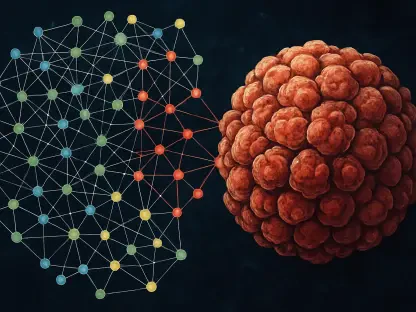Researchers from the Washington University School of Medicine in St. Louis have made significant strides in understanding the pathways responsible for the development and progression of Alzheimer’s disease by examining cerebrospinal fluid (CSF). This study, published in Nature Genetics, highlights the novel approach of leveraging CSF gathered from living patients to link disease-related proteins and genes, identifying specific cellular pathways implicated in Alzheimer’s pathology.
Alzheimer’s disease has long been associated with a plethora of genes, but the precise manner in which these genes contribute to neurodegeneration has remained somewhat enigmatic. Studies have traditionally faced challenges due to the difficulty of examining the brain’s molecular details in living patients. Previously, most investigations relied on brain tissues collected postmortem, which provide limited data restricted to the later stages of Alzheimer’s. Other studies used blood plasma, which does not offer a targeted view of the affected brain tissues. The breakthrough by the researchers at WashU Medicine represents a substantial step forward, as CSF is an excellent proxy for brain activity, providing critical insights into the disease’s pathology at more profound levels.
Leveraging Cerebrospinal Fluid for Alzheimer’s Research
The Importance of CSF in Alzheimer’s Studies
Dr. Carlos Cruchaga, the Barbara Burton and Reuben Morriss III Professor of Psychiatry and director of the NeuroGenomics and Informatics Center at WashU Medicine, emphasized the importance of using human-derived data to identify both risk-linked and protective genes and establish their roles in Alzheimer’s disease. His team undertook an extensive proteomic study of CSF, which is known to reflect the disease’s pathological progression accurately. Their ultimate aim was to map the constellation of protein activity, or the proteome, to understand how genetic variations contribute to Alzheimer’s at the molecular level.
In the last 15 years, the aggregate number of genomic regions associated with Alzheimer’s disease has expanded from 10 to nearly 80. Despite this progress, knowing which genes or regions of DNA are linked to the disease is only the beginning. A holistic view that compares an individual’s proteomic profile – delineating which proteins are active and to what extent – is necessary to understand the related cellular activities in the brain. This comprehensive approach allows researchers to draw a clear connection between genetic variations and their molecular impact on brain function, thus paving the way for targeted therapeutic strategies.
Data Sources and Methodology
By leveraging a trove of data from sources like the Knight Alzheimer Disease Research Center (ADRC) and the Dominantly Inherited Alzheimer Network (DIAN), the scientists had access to the genetic information and CSF samples from 3,506 individuals, consisting of both healthy donors and those with Alzheimer’s disease. Through rigorous cross-referencing of proteomic data from CSF samples with pre-existing genomic studies, the team narrowed down 1,883 proteins from the 6,361 found in the CSF proteomic atlas.
The researchers employed three distinct statistical analyses to identify genes and proteins with high confidence that are part of the biological pathways leading to the disease. This method validated that 38 proteins likely have causal effects on Alzheimer’s progression, with 15 of these proteins being potentially druggable targets. The cornerstone of this analysis is the identification of proteins that modify risk, thereby allowing the mapping of causal steps leading to Alzheimer’s pathology in the brain. By pinpointing these critical proteins, the researchers can better understand how genetic variations cause disease and potentially discover new avenues for therapeutic interventions.
Broader Implications and Future Directions
Extending Research Beyond Alzheimer’s
The broader implications of this study extend beyond Alzheimer’s, as Dr. Cruchaga highlighted the potential of CSF proteomics to decode other neurological conditions such as Parkinson’s disease and schizophrenia. This methodology allows researchers to harness a wealth of data that can be applied to various diseases once an atlas of genetic variants and protein levels is established. Such advancements could lead to significant breakthroughs in our understanding and treatment of numerous neurological disorders. By expanding the scope of CSF proteomic studies, scientists can leverage this data to dissect the molecular underpinnings of many conditions, ultimately informing better healthcare strategies.
Exploring Metabolites as Biomarkers
Proteins, however, are not the sole key to unlocking these conditions. Dr. Cruchaga’s team is also exploring metabolites – compounds released by cells during metabolic processes that are present in CSF. In another paper published in Nature Genetics, the researchers demonstrated the promise of metabolites as biomarkers, establishing associations between specific metabolites and conditions such as Parkinson’s disease, diabetes, and dementia. This dual focus on both proteins and metabolites could herald a new era in neurological research, enhancing our ability to diagnose and treat various conditions at their molecular roots. The inclusion of metabolomic studies provides an additional layer of data that could offer new insights into the biochemical processes behind these diseases, making diagnostics more precise and treatments more personalized.
Conclusion
Researchers at Washington University School of Medicine in St. Louis have made significant advances in studying Alzheimer’s disease by examining cerebrospinal fluid (CSF). Their work, published in Nature Genetics, introduced an innovative technique of using CSF from living patients to explore disease-related proteins and genes, revealing specific cellular pathways linked to Alzheimer’s.
Alzheimer’s has long been associated with numerous genes, but the exact ways these genes cause neurodegeneration have been unclear. Historically, studies struggled to investigate molecular details in living brains. Most past research relied on brain tissues collected postmortem, which only provide data from the later stages of Alzheimer’s, or on blood plasma, which doesn’t focus on affected brain tissues. The WashU Medicine researchers’ breakthrough with CSF represents a major step forward. CSF, an excellent proxy for brain activity, offers crucial insights into Alzheimer’s pathology at deeper levels, enabling a greater understanding of both the development and progression of this disease. This advancement holds promise for improved diagnosis and treatment strategies.









